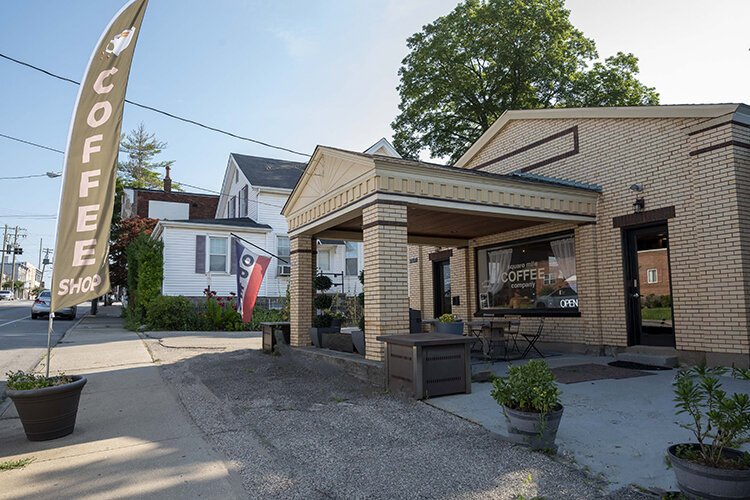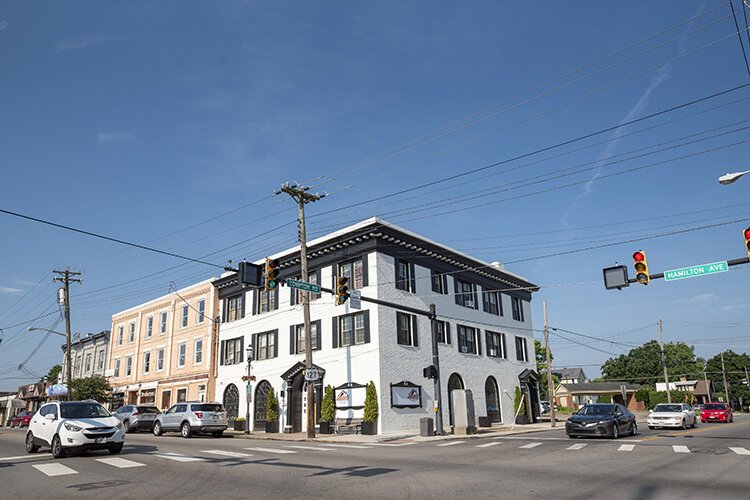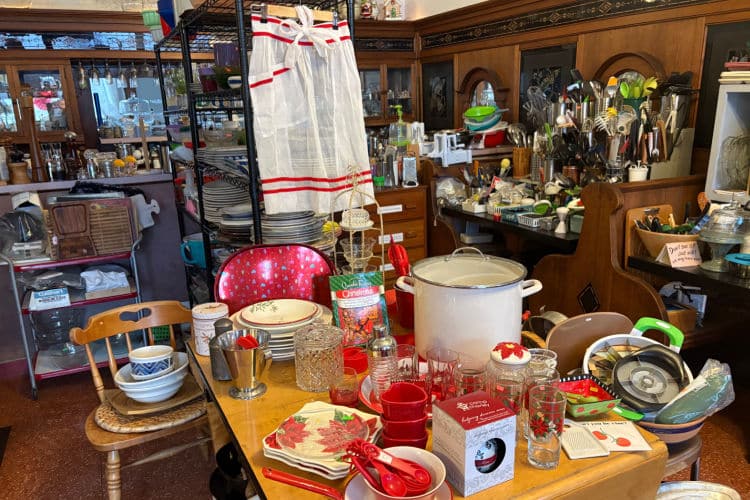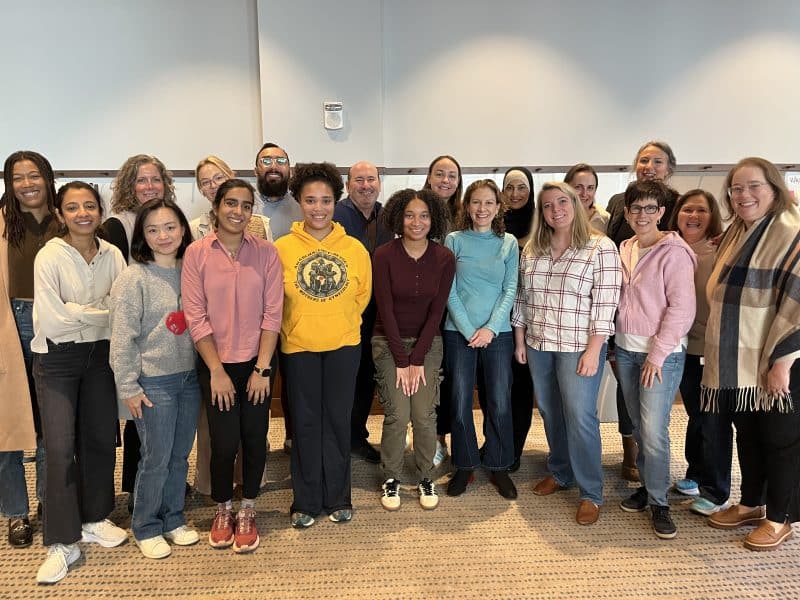‘We’re doing something about it’: How an old community plans for a new start in its third century
A community development corporation is a center of gravity for gathering ideas, organizing residents, and coming up with new solutions for an aging neighborhood.
Cincinnati’s first-ring suburbs face unique challenges. Changing demographics, economic stability, and issues regarding resources and security are common threads among these jurisdictions.
The ways the 49 Hamilton County cities, villages, townships, and municipal corporations not only adjust but thrive is the focus of this series, First Suburbs—Beyond Borders. The series explores the diversity and ingenuity of these longstanding suburban communities, highlighting issues that demand collective thought and action to galvanize their revitalization.
Reimagining a neighborhood often begins with a new gathering place. The revitalization of Walnut Hills took off when Fireside Pizza opened more than a decade ago. In College Hill, a coffee shop served as a cornerstone in that neighborhood’s turnaround. In St. Bernard, a brewpub brings visitors from all over. Coffee, beer and food bring people together and can bring energy and new life to older communities.
The city of Mt. Healthy got a brewpub when Fibonacci Brewing opened at the site of a florists shop in 2015. Five years later, a coffee shop opened in the heart of the city’s business district. Square Mile Coffee debuted in a renovated service station that looked like it had been plucked right out of the 1940s. Actually much older than that, the garage had sat vacant for decades, a reminder of better days gone by in a business district that was slowly on the decline.
Beer, coffee, as well as new owners for a longstanding diner in the Hamilton Avenue business district have brought new energy to Mt. Healthy. Beyond the culinary delights, something more impactful is happening – people power. A group of concerned citizens have formed a community development corporation, a not-for-profit group that can serve as a center of gravity for gathering ideas, organizing residents and coming up with new solutions to the problems of aging neighborhoods.
Community development corporations can be important tools for spurring neighborhood revitalization, economic growth, equitable development, and improving the quality of life in underserved and disinvested communities, the Ohio CDC Association says. They are especially useful in what the association calls “middle neighborhoods.”
“Many middle neighborhoods are in slow decline, demonstrated by stagnant housing markets and declining main streets,” the organization says. “While middle neighborhoods play pivotal roles in their cities, they are in desperate need of stabilization and economic intervention.”
In Mt. Healthy, an all-volunteer group called Third Century, or 3C, has gone to work planning for new businesses, new housing and new life in a town that has seen its population decline by nearly 10% since its peak in the late ’80s, and some longstanding businesses close.
“It’s empowering,” says Dan Glynn, a member of Third Century’s executive board. “Instead of saying, ‘Why doesn’t somebody do something about that,’ we are doing something about it. You can do something about it.”
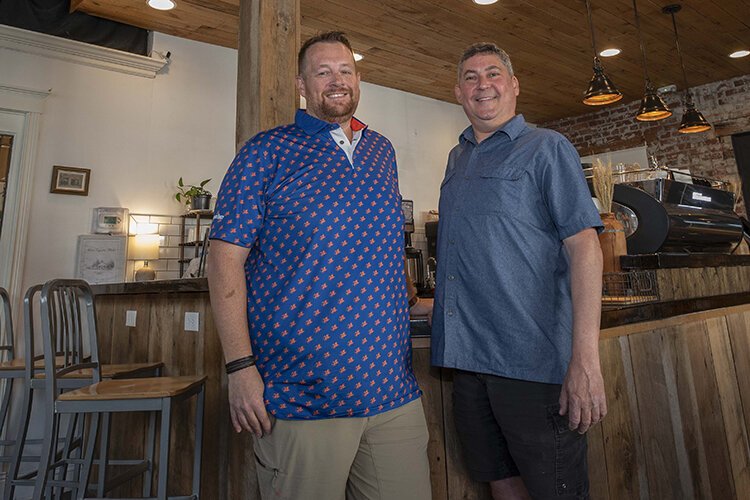
Dave Osterday and Dan Glynn are on the board of 3C, Third Century.
Community development corporations are run by local residents who have a singular mission – to improve the community through housing and economic development. They’re not run by developers who are driven by profit motives or by government leaders who may be hamstrung by regulations, although they work closely with both.
“It’s made up of people whose value systems are more about community building and more about value building than being held to some other economic standard,” says 3C board member Dave Osterday.
He moved to Mt. Healthy 20 years ago as a young architect who appreciated the character of the older houses in the community. He bought a 65-year-old, four-bedroom, two-bath cottage “for a quarter of the price of Hyde Park.”
Glynn grew up in Mt. Healthy, moved away then came back, drawn by his roots and family ties with relatives who have served in local government. The history and character of the community appealed to him.
“You can go to West Chester or a lot of places that are very nice, new, very convenient. But they can’t be 208 years old,” he says. “This place can. I think we need to highlight that for people who are interested in that.”
A community development corporation at its core is created and run by community members – it is, essentially, the community. “We’re local,” Glynn says. “We’re your neighbors; we’re not some out-of-town landlords who are buying up places.”
Third Century got started by capturing community development grant money and putting it to use. A longtime neighborhood business, Angilo’s Pizza, applied for and received assistance for a refresh of its building. “It was looking a little dated and worn,” Osterday says. After new paint, roof repairs, a new façade, new doors and new windows, it’s more inviting.
The group hired urban consulting firm Yard & Co. to engage and survey residents, assess the neighborhood and come up with a visionary plan for the future. The plan visualizes growth and development in two-year increments looking out over the next seven years. The plan includes a space called “The Hive” that would be created for pop-up events by making use of a vacant lot and closing a street. More street trees and a large mural would create a welcoming atmosphere. New, highly visible crosswalks and curb bumpouts would slow traffic on busy Hamilton Avenue and make it more accessible for walkers. New housing and retail space would bring new residents and entrepreneurs.
None of that is set in stone and much of it depends on community input, funding, and government and business community buy-in. But the coffee shop is an early success, the pizza joint makeover is a visible sign of what can be done, and down the street from that, three historic buildings are undergoing renovation, a sign of things to come. Next door to Angilo’s, an art gallery just launched its inaugural exhibition: “The Art of Community — A Celebration of Local Creativity” can be seen at Ethos Art Collective through July 24. A new community event, the Mulberry Festival, was held for the second time in June, and more space was need for vendors and attendees so it was moved to the city park.
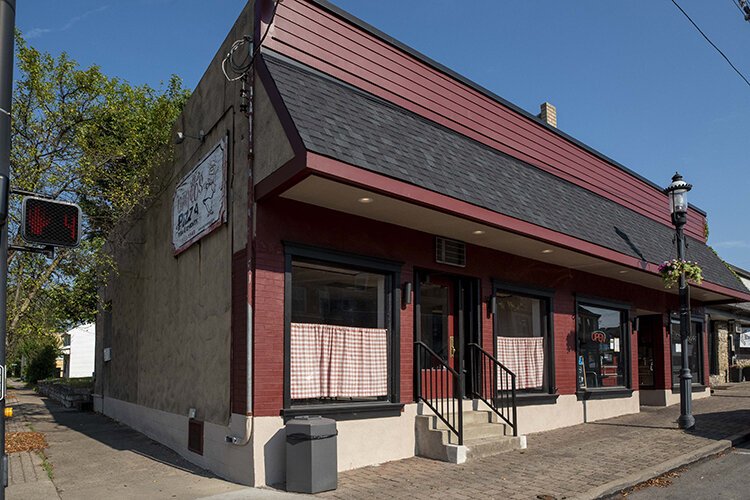
Angilo’s Pizza got a facelift and a freshening up.
Mt. Healthy’s nascent CDC founders tapped into the expertise of HomeBase, a Cincinnati-based not-for-profit that supports community development corporations. They also consulted with their neighbors in College Hill, where one of Cincinnati’s first community development corporations was created in the 1970s. The College Hill Community Urban Redevelopment Corp. has been behind the transformation of that neighborhood’s business district, which also sits along Hamilton Avenue. The College Hill group had a head start of several decades and cautioned that big changes of the sort seen in that community take a long time. College Hill’s organization has invested tens of millions in buying, renovating, and leasing properties. Mt. Healthy’s Third Century doesn’t own any properties yet, but that is on the drawing board.
The College Hill group is led by a professional executive director and staff, which helps greatly with accomplishing goals and achieving the vision. That’s the next step for Mt. Healthy, as the group plans to seek a part-time executive director who can apply for grants, work with business and property owners and the city government.
Back at Square Mile Coffee, general manager Kim Rollins is reflecting on how the town has welcomed her business, which opened in 2020, two months before the Covid shutdown. That episode showed how much the community wanted a place like that, where neighbors, families, and friends can gather. “It kind of was a call that if our community wanted us here, they will show it,” she says. “And they came through. This is a community that deserves it.”
First Suburbs—Beyond Borders series is made possible with support from a coalition of stakeholders including the Murray & Agnes Seasongood Good Government Foundation: The Seasongood Foundation is devoted to the cause of good local government; Hamilton County Planning Partnership; plus First Suburbs Consortium of Southwest Ohio, an association of elected and appointed officials representing older suburban communities in Hamilton County, Ohio.

